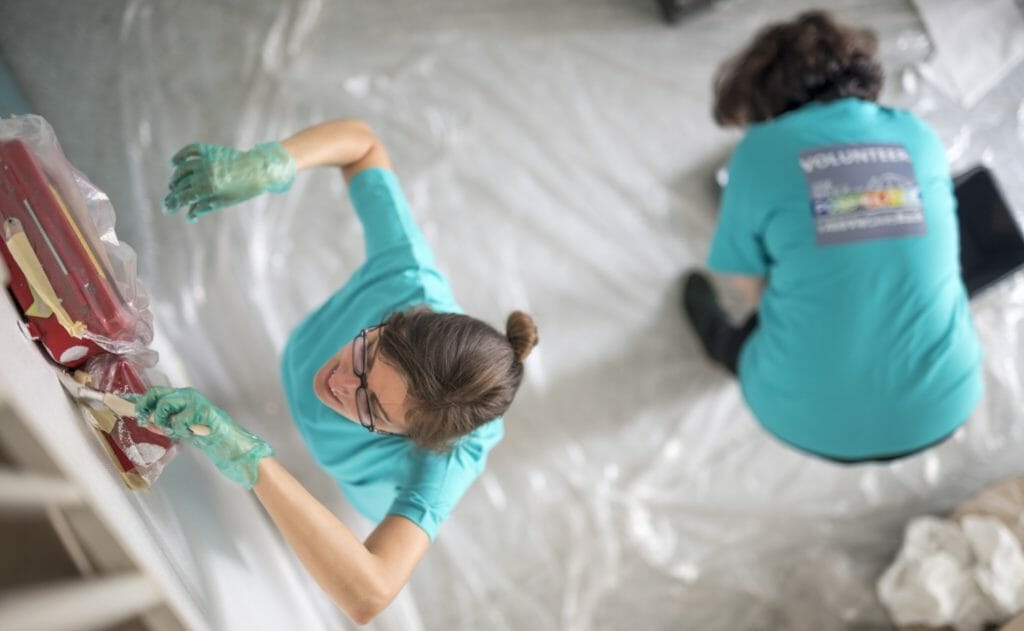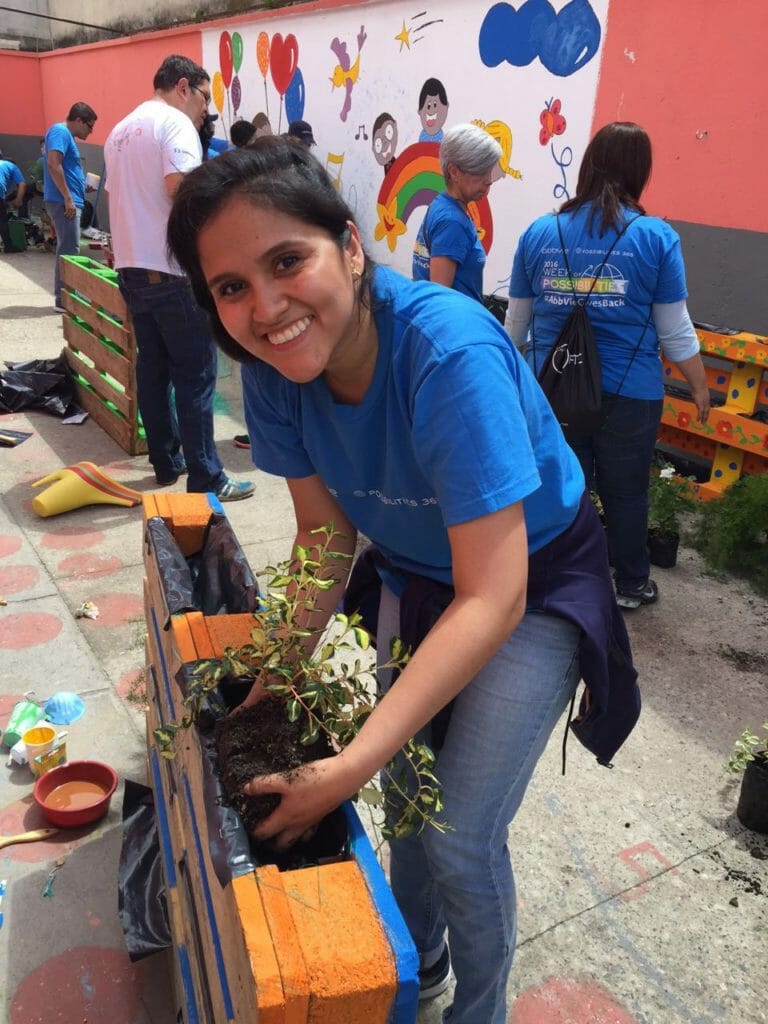Revealing the Secrets to Corporate Volunteering Success
Reprinted with permission from AbbVie.com.

Possibilities Become Realities
In San Jose, California, a playground rises from the concrete in a single day. Across the country, a rundown library in North Chicago, Illinois, is transformed to reflect its city’s brightening future. And thousands of miles away, the wish lists of community centers in Brazil and Ireland are fulfilled.
Every year, during the Week of Possibilities, AbbVie employees from around the globe offer up their talents and time to enrich the communities where they live and work, assisted by financial support by the AbbVie Foundation. But it’s the organizations behind the scenes that truly make it possible to bring more than 6,000 employees in more than 50 countries together for one common goal.
We spoke with leaders from these nonprofit organizations to get a peek behind the curtain, discovering the secrets to successful corporate volunteerism. Jill Hardy Heath, president & CEO of Heart of America Foundation; Gared Jones, senior vice president, global at Points of Light; and James Siegal, CEO, KaBOOM!, share their experience and insight below.
Q: What are the typical ways your organization works with corporate partners?
James Siegal, KaBOOM! (JS): We believe that great things happen when people come together with a common purpose to get things done in their communities. That’s why we build playgrounds the way we do, and that begins with the kids in the community. The kids are asked to draw their dream playgrounds and bring all their creativity and spirit to it. Over the span of a few months, we then work with the community to get them ready to build a playground in one day, with a team of about 200 volunteers from our corporate partner and the community.
Gared Jones, Points of Light (GJ): We’re trying to help companies create innovative, inspiring, meaningful impact in their communities through their employee giving as part of advancing our broader mission, by offering end-to-end solutions that include program design, local project implementation, storytelling that deepens a company’s culture of volunteering and impact reporting. We work with companies all around the world to create days, weeks or months of service; with others, we do year-round employee volunteering.
Jill Heath, Heart of America (JH): We help our corporate partners transform spaces into modern learning environments. This means refurbishing libraries, tech labs and educational spaces, and making sure children have books and technology that inspires learning, like computers, 3-D printers, tablets, interactive whiteboards and more.
Q: How does your organization prepare for a large, international employee volunteer program, like Week of Possibilities?
GJ: Week of Possibilities is one of the biggest and farthest-reaching programs we work with – especially because we’re working in so many places. We support activities directly in 15-20 countries and touching AbbVie program leaders in as many as 50-55 countries. We have a global network of volunteer local organizations led by social entrepreneurs, and we work closely with them to identify the types of needs a company wants to serve in the community. We really want the employees to be able to create the greatest impact. A key part of our approach is focusing on what’s meaningful in those communities, and the only way to do that is our relationship with those local non-governmental organizations (or NGOs).
Q: Have you observed any new trends in corporate volunteerism? How do you think the practice will change in the coming years?
JS: We’re seeing a renewed sense of urgency because people are more disconnected and divided than ever, and there are very few opportunities for people to feel they can make a real, tangible difference. We are all seeking an alternative to what feels like a sense of hopelessness, feeling like nothing is going to change. True, authentic corporate volunteerism with powerful corporate citizens is, I think, an antidote to those things.
JH: In the past few decades, corporate volunteerism has gone from a “nice thing to do” to the cost of doing business, to being an absolute must. Many new hires and the generations graduating from college are looking for an employer that gives back to the community where they live and supports causes in the focus areas that matter to them individually.
GJ: One trend we’re seeing is that with the announcement of the United Nations 2015 Sustainable Development Goals, there are a growing number of companies thinking about their volunteer impact relating to these goals. And companies are using these programs as a way to build culture, corporate identity and to better connect with employees.

Q: Do corporate partners ever unintentionally offend the communities they are trying to serve, and if so, how do you navigate this?
JS: Sometimes it’s the little decisions that people don’t think about that really matter. At all of our playground builds, we serve lunch, and it’s the responsibility of the community to make sure there’s lunch for all the volunteers. A potluck may not be the first choice for a corporate event, but if it provides an opportunity for the community –and these are often people who don’t have significant means –to contribute and showcase their talents and their culture, then it’s the right thing to do. We try and help our corporate partners see why decisions like that matter to the community when the first instinct may be, “let’s make sure everyone has really delicious food from the local restaurant,” as opposed to “this is an opportunity for the community to shine.”
JH: At times, corporate partners are very focused on brand visibility. Brand placement within education and learning environments can be distracting, so whenever we go into a community or a school district, we listen and learn what is appropriate. Then we can guide how to best and authentically design learning spaces that simultaneously honor and recognize the “brand” of a benefactor/corporate partner, while accomplishing what is needed for the beneficiaries.
Q: In your opinion, what makes a “good” corporate partner?
JH: Listening … building community support and giving both what is truly needed for the community and for the business. Remaining thoughtful on how the corporation uses their resources for good, how they build, structure and evolve their giving program and devote their team members’ time and talent in the right places.
GJ: Authentic leaders. The more that the culture resonates with the desire to impact communities and give back, and the more the company’s leaders are espousing those values, the easier it is to do really cool things. Also, it’s great to have clarity on what the program goals are, what’s driving it – is it employee engagement? Is it impacting education? And lastly, we love when partners come with a spirit of partnership and adaptability – a willingness to flex based on what a company is learning in the process.
JS: If the partner is interested first and foremost in how its brand will show up, that can lead to challenges. But if the partner comes to the table saying we’re here to make a difference in a community where our employees work or our stakeholders live, that really is the key to success. The best corporate partners are driven by authentic engagement and the desire to make a real, tangible difference.
Q: What is the one thing you wish corporate partners knew that could make your partnerships more effective?
GJ: That it’s important to start with a spirit of co-creation and engage in a dialogue about what’s most meaningful in a particular community. Last year, we were working with AbbVie in Brazil for Week of Possibilities, rebuilding a youth center. But the community said what they really needed was staff for this center. So we worked with AbbVie to hire someone to develop a curriculum and had AbbVie employees volunteer to teach. Shaping volunteer activities based on what communities really need allows companies to have the greatest impact.
JS: We work in some of the most challenged communities in this country – communities dealing with extreme adversity. You can only imagine what it’s like growing up in a community like that. And I think we have to go the extra mile and push ourselves out of our comfort zone to make a difference in their lives, and that can feel uncomfortable. Sometimes corporate partners can be risk adverse in that sense. But when they step up, it makes a difference – your employees know it, your stakeholders know it, and when it does happen, it’s magical.